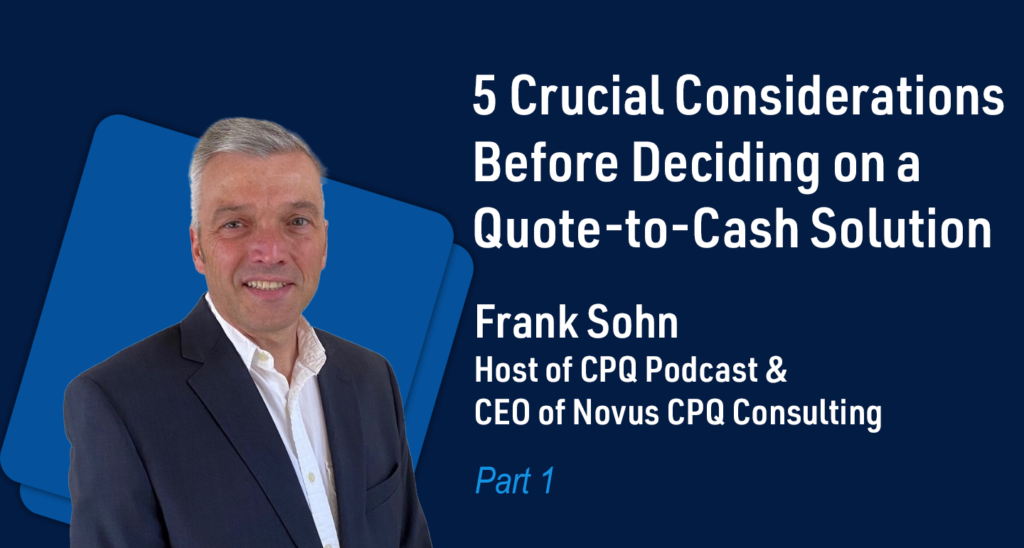5 Crucial Considerations Before Deciding on a Quote-to-Cash Solution, Pt. 1
As 2024 begins, do you have a Configure-Price-Quote (CPQ) solution on your company’s investment list? Whether you’re a first-timer or seeking an upgrade, choosing the right quote-to-cash solution requires careful thought. This blog post (part 1 of a 2-part post) explores three of the five crucial areas to consider before making that crucial decision, with the five being:
1. Total cost
2. Industry suitability
3. Integration capabilities
4. User Acceptance criteria
5. Effort surrounding implementation and ongoing maintenance
Given the amount of ground we’re covering in these different areas, this entire blog post – with all five areas – is going to be a bit lengthy. To make it more manageable, I’ve decided to split it into two parts. This first part will focus on crucial areas 1-3, and the next post will delve into areas 4 and 5.
So, let’s get started.
Crucial Consideration #1: Cost:
When evaluating costs, consider two key aspects: Total Cost of Ownership (TCO) and Implementation Speed.
TCO goes beyond the initial purchase price. It includes ongoing maintenance fees, software upgrades, and potential integrations with other systems (e.g., adding a CAD integration to Solidworks later). Additionally, consider who handles these tasks. Can your internal RevOps team manage all of them or will they need to rely on IT? Or will you also need external consultants or system integrators? Performing tasks internally can lower TCO, but only if the technology is sufficiently user-friendly.
Implementation Speed refers to how quickly your chosen CPQ solution can be up and running. Many companies underestimate the time and effort involved in setting up and configuring a solution for their entire team’s needs, including their administrators and channel partners. To get a realistic picture, seek references from similar companies facing similar challenges. Remember, every customer will have unique requirements. Easy administration is crucial for occasional UI layout changes, quote customization, product configuration, pricing rules and more. Complicated administration and configurations will take longer, cost more, and lead to lower user – and administrator – satisfaction.
Crucial Consideration #2: Industry Suitability
When choosing a quote-to-cash solution, industry suitability is critical. Not all CPQ solutions are created equal, so finding one tailored to your specific industry’s complexities and sales processes is essential. Consider these two key aspects: Target Market Fit and Adaptability.
Target Market Fit
Ensure the solution is specifically built for your industry’s complexities and sales processes, including your specific target market. Consider who will use it:
- Internal sales team: They need detailed pricing information, discount options, customization options and more.
- Channel partners: They may require channel partner specific pricing and channel partner specific quoting and more.
- Online customers: They expect a simple interface with clear pricing, straightforward negotiations and more.
Also pay attention to whether industry-typical scenarios will be covered out-of-the-box. Avoid solutions requiring extensive modifications to handle common situations for your industry.
Adaptability
The solution should also blend seamlessly with your unique business processes, sales strategy, and approval flows. Look for a solution that allows your team to make adjustments quickly and intuitively, without requiring extensive technical expertise.
Remember, the best CPQ solution adapts to your needs, not the other way around. By focusing on industry suitability and adaptability, you’ll find a solution that empowers all your users, streamlines your processes, and, in the end, drives revenue growth and customer satisfaction.
Crucial Consideration #3: Integration Capabilities
When choosing a quote-to-cash solution, ensuring seamless integrations with your existing core systems is critical – as well as bi-directional data flows with all data sources and systems. Let’s look at this a little closer.
Seamless Connections with Your Core Systems
The CPQ solution should pull data (customer details, product information, pricing etc.) from all existing systems, like your CRM and ERP. Out-of-the-box integrations with popular systems like Salesforce and Microsoft Dynamics are common, but for other systems – like e-commerce platforms, inventory management, PLM, PDM, CAD, and others – deeper investigation might be needed.
Here’s how to dig deeper:
- Ask the vendor for a detailed list of their out-of-the-box integration solutions.
- Clarify their definition of “out-of-the-box” to understand the level of pre-built connections.
- Seek estimated integration times for your specific systems to gauge the effort involved. Remember, first-time integrations often take longer and may encounter unforeseen complexities.
Bi-directional data flow with crucial systems like CRM and ERP is essential
The information may need to flow between your CPQ solution to multiple backend systems, eliminating data silos and operational headaches for your IT team. This is especially true for larger customers or customers who regularly deal with M&A transactions. Remember, depending on your specific business needs, other integrations might be equally important.
If the vendor offers a no-code/low-code CPQ, then requisite integrations and customized data and workflows may be easier to manage and adapt over time, causing fewer implementation and ongoing usage concerns.
Otherwise, I recommend companies choose a solution that can seamlessly:
- Adapt to future system upgrades and changes to avoid custom code dependence and future technical complications.
- Offer a smooth and simple integration experience to minimize technical burden and maximize operational efficiency.
Whew, we covered a lot.
We’ve delved into three crucial areas to consider when choosing a quote-to-cash solution: cost, industry suitability, and integration capabilities. Each plays a significant role in the success of your project, and overlooking any can lead to unforeseen challenges. The next blog post will tackle the remaining two pieces of the puzzle: user acceptance criteria and implementation/maintenance considerations.
With this information in hand, you’ll be equipped to make an informed decision and set your 2024 CPQ project up for success. Stay tuned…


Leave A Comment